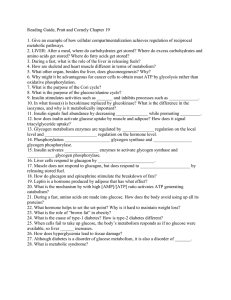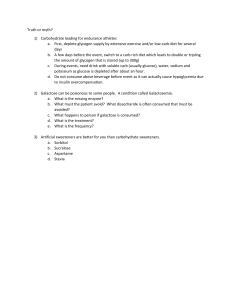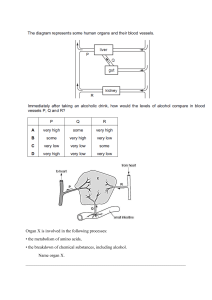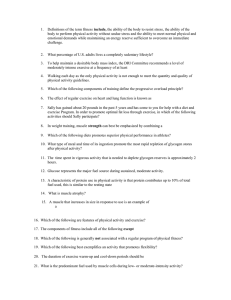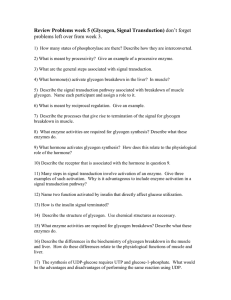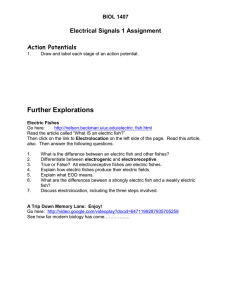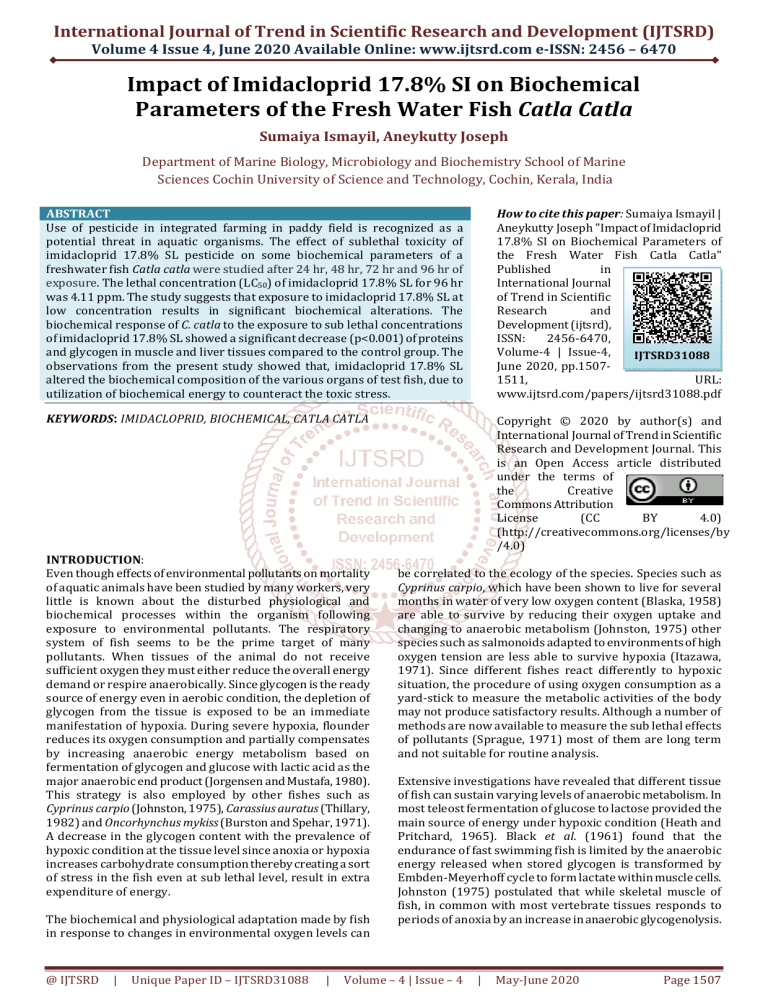
International Journal of Trend in Scientific Research and Development (IJTSRD)
Volume 4 Issue 4, June 2020 Available Online: www.ijtsrd.com e-ISSN: 2456 – 6470
Impact of Imidacloprid 17.8% SI on Biochemical
Parameters of the Fresh Water Fish Catla Catla
Sumaiya Ismayil, Aneykutty Joseph
Department of Marine Biology, Microbiology and Biochemistry School of Marine
Sciences Cochin University of Science and Technology, Cochin, Kerala, India
ABSTRACT
Use of pesticide in integrated farming in paddy field is recognized as a
potential threat in aquatic organisms. The effect of sublethal toxicity of
imidacloprid 17.8% SL pesticide on some biochemical parameters of a
freshwater fish Catla catla were studied after 24 hr, 48 hr, 72 hr and 96 hr of
exposure. The lethal concentration (LC50) of imidacloprid 17.8% SL for 96 hr
was 4.11 ppm. The study suggests that exposure to imidacloprid 17.8% SL at
low concentration results in significant biochemical alterations. The
biochemical response of C. catla to the exposure to sub lethal concentrations
of imidacloprid 17.8% SL showed a significant decrease (p<0.001) of proteins
and glycogen in muscle and liver tissues compared to the control group. The
observations from the present study showed that, imidacloprid 17.8% SL
altered the biochemical composition of the various organs of test fish, due to
utilization of biochemical energy to counteract the toxic stress.
How to cite this paper: Sumaiya Ismayil |
Aneykutty Joseph "Impact of Imidacloprid
17.8% SI on Biochemical Parameters of
the Fresh Water Fish Catla Catla"
Published
in
International Journal
of Trend in Scientific
Research
and
Development (ijtsrd),
ISSN:
2456-6470,
Volume-4 | Issue-4,
IJTSRD31088
June 2020, pp.15071511,
URL:
www.ijtsrd.com/papers/ijtsrd31088.pdf
KEYWORDS: IMIDACLOPRID, BIOCHEMICAL, CATLA CATLA
Copyright © 2020 by author(s) and
International Journal of Trend in Scientific
Research and Development Journal. This
is an Open Access article distributed
under the terms of
the
Creative
Commons Attribution
License
(CC
BY
4.0)
(http://creativecommons.org/licenses/by
/4.0)
INTRODUCTION:
Even though effects of environmental pollutants on mortality
of aquatic animals have been studied by many workers, very
little is known about the disturbed physiological and
biochemical processes within the organism following
exposure to environmental pollutants. The respiratory
system of fish seems to be the prime target of many
pollutants. When tissues of the animal do not receive
sufficient oxygen they must either reduce the overall energy
demand or respire anaerobically. Since glycogen is the ready
source of energy even in aerobic condition, the depletion of
glycogen from the tissue is exposed to be an immediate
manifestation of hypoxia. During severe hypoxia, flounder
reduces its oxygen consumption and partially compensates
by increasing anaerobic energy metabolism based on
fermentation of glycogen and glucose with lactic acid as the
major anaerobic end product (Jorgensen and Mustafa, 1980).
This strategy is also employed by other fishes such as
Cyprinus carpio (Johnston, 1975), Carassius auratus (Thillary,
1982) and Oncorhynchus mykiss (Burston and Spehar, 1971).
A decrease in the glycogen content with the prevalence of
hypoxic condition at the tissue level since anoxia or hypoxia
increases carbohydrate consumption thereby creating a sort
of stress in the fish even at sub lethal level, result in extra
expenditure of energy.
The biochemical and physiological adaptation made by fish
in response to changes in environmental oxygen levels can
@ IJTSRD
|
Unique Paper ID – IJTSRD31088
|
be correlated to the ecology of the species. Species such as
Cyprinus carpio, which have been shown to live for several
months in water of very low oxygen content (Blaska, 1958)
are able to survive by reducing their oxygen uptake and
changing to anaerobic metabolism (Johnston, 1975) other
species such as salmonoids adapted to environments of high
oxygen tension are less able to survive hypoxia (Itazawa,
1971). Since different fishes react differently to hypoxic
situation, the procedure of using oxygen consumption as a
yard-stick to measure the metabolic activities of the body
may not produce satisfactory results. Although a number of
methods are now available to measure the sub lethal effects
of pollutants (Sprague, 1971) most of them are long term
and not suitable for routine analysis.
Extensive investigations have revealed that different tissue
of fish can sustain varying levels of anaerobic metabolism. In
most teleost fermentation of glucose to lactose provided the
main source of energy under hypoxic condition (Heath and
Pritchard, 1965). Black et al. (1961) found that the
endurance of fast swimming fish is limited by the anaerobic
energy released when stored glycogen is transformed by
Embden-Meyerhoff cycle to form lactate within muscle cells.
Johnston (1975) postulated that while skeletal muscle of
fish, in common with most vertebrate tissues responds to
periods of anoxia by an increase in anaerobic glycogenolysis.
Volume – 4 | Issue – 4
|
May-June 2020
Page 1507
International Journal of Trend in Scientific Research and Development (IJTSRD) @ www.ijtsrd.com eISSN: 2456-6470
In most all these circumstances the major share of energy
comes from the carbohydrate or glycogen reserves. Thus
carbohydrate forms the central point in energy production
because of great mobility in the living systems, together with
its capacity to get compartmentalized within cell and tissues.
The
mobility
is
provided
by
glucose
and
compartmentalization by glycogen and glucose-6-phosphate.
Effects of environmental stress due to chemical pollution on
tissue glycogen levels of fish have also been reported by Leay
and Brown (1975). These studies involving exposure of
fishes to different pollutants have indicated that the
pollution stress stimulates glycogenolysis in fish tissues.
From a biochemical point of view, life is uniquely
characterized by its association with proteins. Tissue protein
as energy source for fishes during thermal stress, spawning
and muscular exercise have been demonstrated by several
investigators. Though considerable information is available
dealing with the determination of acute toxic levels of
several pollutants and their influence on oxidative
metabolism studies on the tissue energy sources are
relatively few.
Adrenocortical hormones are known to influence
mammalian intermediary metabolism by stimulating protein
metabolism (Freeman and Idler, 1973). It now known that
these hormones are produced during stress. Hence stress
created by the exposure of toxic substances interferes with
the intermediary metabolism and affect the protein content
of the body. Glycogen and protein present in liver and
muscles provide energy to the body. Animal under stress
deplete the energy sources at different rates. A study was
designed to observe the influence of imidacloprid 17.8% SL
on tissue level glycogen and protein in C. catla.
MATERIALS AND METHODS
The test organisms are collected and acclimatized in the
laboratory for 15 days. The temperature in the tank during
the experiment was maintained at 26-270c, pH at 7-7.5,
Dissolved oxygen 6-6.8 mg/L and salinity at 0 ppt. The
saturation of oxygen was maintained by giving aeration in
the tank. During acclimatization period the fishes were fed
with commercial fish feed.
The fishes of size range 5-6 cm in length were selected for
the experiment irrespective of the sex. Feeding of fishes was
done one hour before changing the water. Fishes are
transferred into each experimental tank. Each tank
contained 20 L of water. Based on the LC50 values, three sub
lethal concentrations of imidacloprid 17.8% SL were
selected and added to each experimental tank. One tank kept
as control. Replicates were run for each concentration. The
medium was renewed every 24 hours. On 10th, 20th and 30th
days of experiment the fishes caught from the tank and liver
and muscle tissues were collected from the dissected fishes.
The tissue are weighed and then homogenized with 5% TCA.
The homogenate was made into a known volume with 5%
TCA and centrifuged at 3000 rpm for 15 minutes. The
residue was taken for the estimation of protein and the
supernatant was use for the estimation of glycogen. Glycogen
in the liver and muscle tissueswas estimated using the
method of Montgomery (1957) and protein concentration
was determined using the method of Lowery et al. (1951).
RESULT
The results of the experiment showed significant reduction
in the level of glycogen and protein in liver and muscle of
imidacloprid 17.8% SL treated fish (Table 1.). During the
exposure the changes reported in control were insignificant
but in case of fishes treated with sub lethal concentrations of
imidacloprid 17.8% SL the observed changes were
significant.
After 10 days of exposure to sublethal concentrations of
imidacloprid 17.8% SL the changes noted in the amount of
muscle protein (Fig 1.) and liver protein (Fig 2.) showed a
significant variation from the control fishes. The liver muscle
glycogen (Fig 3.) and liver glycogen content (Fig 4.) showed
similar results. The decrease in muscular protein and liver
protein content of imidacloprid 17.8% SL exposed fish after
20 days was accompanied by a depletion of musculsr
glycogen and hepatic glycogen content. The decrease in
protein was more for muscle than for liver where as the
depletion of glycogen was almost equal in both the tissues.
The ANOVA of the protein concentration in the treated and
control fishes, after 30 days of exposure showed significant
reduction in all the sub lethal concentrations. As with
protein content, the amount of glycogen in muscle and liver
tissues of fishes of which were survived in 0.27 pp. 0.41 ppm
and 0.82 ppm concentrations imidacloprid 17.8% SL best
explained a significant reduction in ANOVA analysis.
Table1. Variations in biochemical parameters during confidor exposure in C. catla.
Duration of exposure
parameters
control
0.27 ppm
0.41 ppm
0.82 ppm
Muscle protein 67.58±0.92 61.61±1.09* 57.89±0.71* 53.17±0.34*
Liver protein
55.43±0.71 52.06±0.24* 48.15±0.60* 43.24±0.46*
10 days
Muscle glycogen 3.72±0.27
3.19±0.09*
2.91±0.03*
2.77±0.05*
Liver glycogen
6.78±0.09
6.47±0.07*
5.99±0.08*
5.78±0.77*
Muscle protein 67.31±1.11 59.59±1.90* 56.17±0.36* 48.99±1.23*
Liver protein
55.03±1.28 50.13±0.41* 42.12±1.13* 39.18±0.33*
20 days
Muscle glycogen 3.62±0.14
3.02±0.01*
2.81±0.10*
2.47±0.07*
Liver glycogen
6.63±0.14
6.25±0.5*
5.78±0.20*
5.23±0.16*
Muscle protein 67.44±0.67 57.27±0.21* 51.12±1.26* 42.82±0.62*
Liver protein
54.89±1.34 45.04±0.21* 36.95±0.94* 32.38±0.77*
Muscle glycogen 3.52±0.12
2.90±0.10*
2.18±0.06*
1.88±0.06*
30 days
Liver glycogen
6.66±0.17
6.48±0.65*
5.55±0.04*
4.89±0.07*
Value ± SD *Significance level at (p<0.001)
Dose dependent effect of imidacloprid 17.8% SL on tissue energy reserves of C. catla was observed after 30 days of exposure.
The depletion of protein and glycogen was more for the fishes exposed to the highest concentration (0.82 ppm).
@ IJTSRD
|
Unique Paper ID – IJTSRD31088
|
Volume – 4 | Issue – 4
|
May-June 2020
Page 1508
Amount of protein (mg/g wet weight of
tissue)
International Journal of Trend in Scientific Research and Development (IJTSRD) @ www.ijtsrd.com eISSN: 2456-6470
80
70
60
50
40
30
20
10
0
10 days
20 days
30 days
Amount of protein (mg/g wet weight of
tissue)
Timeinofexperimental
exposure fishes.
Fig.1. Protein content of muscle
60
50
40
30
20
10
0
10 days
20 days
30 days
Amount of protein (mg/g wet weight
of tissue)
Time
of exposure fishes.
Fig.2. Protein content of liver
in experimental
4
3.5
3
2.5
2
1.5
1
0.5
0
10 days
20 days
30 days
Fig.3. Glycogen content of muscle in experimental fishes.
@ IJTSRD
|
Unique Paper ID – IJTSRD31088
|
Volume – 4 | Issue – 4
|
May-June 2020
Page 1509
International Journal of Trend in Scientific Research and Development (IJTSRD) @ www.ijtsrd.com eISSN: 2456-6470
Fig.4. Glycogen content of liver in experimental fishes.
DISCUSSION
Kumar et al. (1994) studied on the effect of endosulfan in
Clarius batrachus and reported that the rapid use of pesticide
to control pests poses serious hazard to non target
organisms including fishes in the aquatic bodies. Pesticides
reaches aquatic bodies by direct application, spray from
ground or aerial, atmosphere fallout, run-off from
agricultural land and discharge of effluents. These pesticides
persist in the environment and are found to be toxic to
various aquatic animals including fishes. David et al. (2004)
conducted a experiment on cypermethrin in Thilapia
mossambicuss and reported that the carbohydrates are the
primary and intermediary source of energy and in stress
conditions carbohydrates depleted to meet energy demand.
In the present study a decrease in carbohydrate energy
source, glycogen in liver and muscle tissues of imidacloprid
17.8% SL treated C. catla as reported. The glycogen level of
both the tissues showed a decreasing trend as treatment
progressed. Depletion of glycogen may be due to direct
utilization for energy generation, a demand caused by
imidacloprid 17.8% SL induced hypoxia.
According to Rand and Petrocelli (1988) layering over gill
membrane and filaments in the fish alters the aerobic nature
and a shift towards anaerobiosis with decrease in stored
carbohydrates. Results of the biochemical studies in C. catla
showed similar results. Decline in glycogen content of
muscle and liver after toxic stress have been reported in
studies with aquatic animals by Shoba et al. (1989) and Hori
et al. (2006). Similar drop off in glycogen in Clarias batrachus
was observed after fish were intoxicated with
organophosphate pesticide dimethoate and roger was
reported from the works of Begum and Vijayaraghavan
(1999). The depletion of glycogen in the tissues is an
indication of typical stress response in fish challenged with
pesticides. The observed reduction in glycogen content
indicates the utilization of stored glycogen to meet the highly
energy requirement under pesticide stress. Significant dose
dependent decrease in glycogen content of tissue was
observed in all the three sublethal concentrations of
imidacloprid 17.8% SL.
Shamsi and Al-Akel (1986) studied on mercuric chloride
treated Oreochromis niloticus and reported that exposure to
@ IJTSRD
|
Unique Paper ID – IJTSRD31088
|
various toxicants considered stress full such as heavy metal.
Effect of endosulfan in Cyprinus carpio studied by
Chandransekhar and Jayabalan (1993) and results shows
that, the reduction in the muscle liver glycogen of the fish.
Glycolysis in the fish exposed to pollutants may be expected
to meet the energy requirements of the animal for the
increased level of physical activity. The decrease in tissue
glycogen of the fish exposed to different concentrations of
imidacloprid 17.8% SL shows maximum decrease at highest
dose concentration, indicating the mobilization of energy
reserve to meet energy crisis. Nakamo and Tomlinson
(1967) studied on the catecholamine and carbohydrate
concentration in Salmo gairdneri in relation to physical
disturbances and reported that disturbances are related to
enhance circulating levels of both catecholamines and
glucocorticoids. Thus the reduction in the level of glycogen in
muscle and liver exposed to imidacloprid 17.8% SL in
presence study may be related to stress induced increase in
circulating catecholamines and adrenocorticostreroids.
Since fish have a very little amount of carbohydrate so next
alternative source of energy is protein to meet the increased
energy demand (Rao, 1999). The concentration of total
protein in liver and muscle of C. catla exposed to
imidacloprid 17.8% SL were found to be lower than those in
control on all sampling days. Similar findings have been
noted in fresh water field crab, Barytelphusa guerini on
exposure to endosulfan by Reddy et al. (1991), and in the
fish Notopterus notopterus exposed to various forms of stress
by Narasimhan and Sundararaja (1971). The feasible
explanation for these observations is that proteolytic activity
was induced in these organisms due to stress. The decrease
in protein level in liver and muscle tissues may be due to
meet the higher energy demands for metabolic purposes.
Another hypothesis has been advanced to explain the
reduced protein level in B.guerini exposed to pesticide
endosulphan by Reddy et al. (1991) reported that the
physiological compensatory mechanisms are activated to
either to provide intermediate for deriving energy through
Kreb’s cycle or to compensate for osmoregulatory problems
by increasing the free amino acid level in blood; such
mechanisms would have possibly operated in the test fishes
exposed to imidacloprid 17.8% SL in the present study.
Volume – 4 | Issue – 4
|
May-June 2020
Page 1510
International Journal of Trend in Scientific Research and Development (IJTSRD) @ www.ijtsrd.com eISSN: 2456-6470
CONCLUSION
The result of the present study indicate that imidacloprid
17.8% SL exposure during sublethal treatment induces
significant changes in the biochemical parameters of C. catla.
Tissue level protein and glycogen showed a significant
reduction when the fishes were treated with sub lethal
concentrations of imidacloprid 17.8% SL. Reduction was
more evident in muscle tissues. Under the light of this study,
it could be concluded that even at sub lethal levels
imidacloprid 17.8% SL can cause depletion of energy
resources in fishes. These changes may be potentially
disruptive on the survivability of C. catla. This fact should be
taken into consideration when imidacloprid 17.8% SL is
used for pest control applicatons.
REFERENCES
[1] Begum, G., Vijayaraghvan S. (1999) Effect of acute
exposure of the organophosphate insecticide rogor on
some biochemical aspect of Clarias batrachus.
Environmental Research. 80:80-83.
[2] Black, E.C., Connor, A. R., Parket, R. R. (1961) Some
aspects of carbohydrate metabolism in fish,
Washington Press, 89-122.
[3] Blaska, P. (1958) The anaerobic metabolism of fish.
Physiological Zoology, 31, 117-128.
[4] Burston, D. T., Spehar, A. M. (1971) A revaluation of the
anaerobic end product of fresh water fish exposed to
environmental hypoxia. Journal of Comparative
Biochemistry and Physiology 40, 945-954.
[5] Chandrasehar, S., Jayabalan, N., (1993) Responses of
the carp, Cyprinus carpio exposed to the pesticide
endosulfan. Asian Fish. Sri.6, 331-340.
[6] David, M., Shivakumar, H. B., Mushigeri, S. B., Ganti B. H.
(2004) Toxicity evaluation of cypermethrin and its
effects on oxygen consumption of fresh water fish
Tilapia mossambica. Indian J. Environ.Toxico. 13(2):99102.
[7] Freeman, H. L., Idler, A. (1973) Effects of
corticosteroids on liver transaminase in Rinbow trout
and the Brook trout. Journal of General and
Comparative Endocrinology 20, 69-75.
[8] Heath, A. G., Pritchard, A. W. (1965) Effects of severe
hypoxia on carbohydrate energy source and
metabolism in two species of fresh water fish. Journal
of Physiological Zoology 38, 325-334.
[9] Hori, T. S., Avilez, F., Morases, G. (2006) Metabolical
changes induced by chronic phenol exposure in fishes.
Comp.Biochem.Physiol. 143:67-72.
[10] Itazawa, Y. (1971) An estimation of minimum level of
dissolved oxygen in water required for normal life in
fish. Bulletin of the Japanese Society for the Scientific
Fisheries 37, 273-276.
[11] Johnston, I. A. (1975) Anaerobic metabolism in the
carp. Journal of Comparative Biochemistry and
Physiology 51, 235-241.
@ IJTSRD
|
Unique Paper ID – IJTSRD31088
|
[12] Jorgensen, J. B., Mustafa, T. (1980) The effect of hypoxia
on carbohydrate metabolism in flounder utilization of
glycogen and accumulation of glycolytic end products
in various tissues. Journal of Comparative Biochemistry
and Physiology 67, 243-248.
[13] Kumar, G. B., Bijoy, N. S., Archana, K. T., Sajeevan, K.
(2014) Curative effects of vitamin C on the variation in
biochemical and histopathological parameters induced
by copper exposure in the teleost fish, Anabas
testudineus. Journal of Environmental Science,
Toxicology and Food Technology, Vol. 8, 28-35.
[14] Leay, M. D. J., Brown, D. A. (1975) Effects of acute
exposure to bleached kraft pulpmill effluent on
carbohydrate metabolism on juvenile Coho salmon
during rest and exercise. Journal of the Fisheries
Research Board of Canada 32, 753-760.
[15] Lowry, O. H., Roserbrough, N. J., Farr, A. L. , Randall, R. J.
(1951) Protein measurement with Folin phenol
reagent. Journal of Biological Chemistry 193, 265-275.
[16] Montgomery, R. (1957) Determination of glycogen.
Archives of Biochemistry and Biophysics. 378-387.
[17] Nakamo, T., Tomlinson, N. (1967) Catecholamine and
carbohydrate concentrations in Salmo gairdneri in
relation to physical disturbances. J. Fish. Res. Bd. Can.,
24:1701-1715.
[18] Narasimhan, P. V., Sunderaraj, B. I. (1971) Effects of
stress on carbohydrate metabolism in the teleost
Notopterus notopterus. Environmental Quality.30:768775.
[19] Rand G. M., Potrocelli, S. R. (1988) Fundamentals of
aquatic toxicology: methods and applications. London,
Hemisphere publishing, pp.1-28.
[20] Rao (1999) Proc. Br. Insectic Fungic. Conf. 2, 36-45.
[21] Reddy, A. N., Venugopal, N. B., Reddy S. L. V. (1991)
Effects of endosulfan 35EC on certain aspects of
protein metabolism in various tissues of a fresh water
field crab, Barytelphusa guerini. Pestic. Biochem.
Physiol. 39:121.
[22] Shamsi, M. I. K., Al-Akel, A. S. (1986) Effects of mercuric
chloride on glycogen content in the various tissues of
freshwater fish Oreochromis niloticus. Proc. Saudi Biol.
Soc, 9:271-276.
[23] Shoba, R. J., Venkateswara, P. V., Janaiah, C., (1989)
Changes in carbohydrate metabolism of Clarias
batrachus when exposed to two organophosphorus
insecticides. J.Fish Biol. 4:51-57.
[24] Sprague, J. B. (1971) Measurement of pollutant toxicity
to fish. Bioassay methods of acute toxicity. Journal of
Water Research 4, 3-32.
[25] Thillary, V. G. (1982) Adaptation of fish energy
metabolism to hypoxia and anoxia. Molecular
Physiology 2, 49-61.
Volume – 4 | Issue – 4
|
May-June 2020
Page 1511

